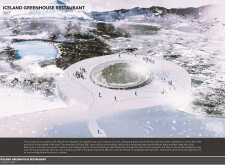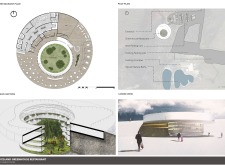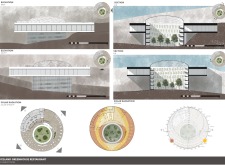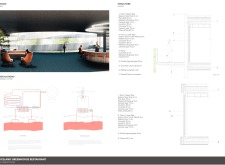5 key facts about this project
The function of the Iceland Greenhouse Restaurant is multifaceted. It combines the roles of a dining establishment and a greenhouse, creating a space where local produce can be grown and prepared on-site. This integration underscores a commitment to freshness and sustainability, allowing for a farm-to-table concept that aligns with contemporary culinary trends. This dual function enhances the culinary experience, as patrons can enjoy meals made from ingredients that are cultivated just steps away from their dining table.
The architectural design of the restaurant showcases a circular layout that revolves around a central greenhouse. This configuration not only facilitates optimal views of the lush greenhouse but also promotes a sense of community among diners, as tables are arranged in clusters to encourage social interaction. The design incorporates a progressive access route that leads visitors from the exterior environment into the greenhouse and ultimately to the dining area, creating an experiential journey that heightens appreciation for both food and nature.
The choice of materials plays a crucial role in the project's overall aesthetic and functional performance. The use of concrete for structural elements ensures the durability necessary for the harsh Icelandic climate, while double-layered glass walls serve as transparent barriers that allow for excellent visibility and natural light within the space. This careful selection of materials contributes to comfort while also emphasizing the connection with the natural landscape. Wood finishes in the restaurant's interior add warmth, creating an inviting atmosphere that contrasts beautifully with the cooler exterior.
One of the more unique design approaches taken in this project is the incorporation of local geothermal energy systems, which exemplifies a commitment to environmental responsibility. This decision not only enhances the building's energy efficiency but also aligns with Iceland's use of renewable resources, demonstrating how architecture can harmoniously integrate with local environmental practices. Additionally, the greenhouse aspect of the design opens possibilities for engaging with local agricultural traditions, providing a platform for education about sustainable food practices.
The restaurant’s placement on a mountaintop provides diners with sweeping views of the surrounding landscape, enhancing their connection to nature. This strategic orientation of the building captures various aspects of the environment, allowing guests to engage with their surroundings visually and contextually. The overall form of the architecture is designed to blend seamlessly with the natural contours of the landscape, reinforcing the idea that built environments can coexist and complement the natural world.
In summary, the Iceland Greenhouse Restaurant is an exemplar of how thoughtful architectural design can create a cohesive experience that prioritizes sustainability, community, and interaction with nature. The integration of a greenhouse within a culinary environment presents a novel approach to dining that emphasizes freshness and local cuisine. For those interested in further exploring this project, a deeper dive into the architectural plans and sections will reveal the intricate details of the design and the innovative ideas that brought this vision to life. Engage with the project presentation to uncover the full scope of this architectural endeavor and understand how design can enhance our relationship with the environment.


























